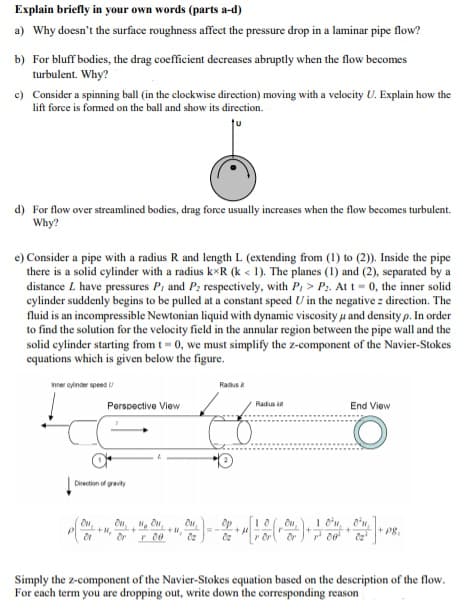a) Why doesn’t the surface roughness affect the pressure drop in a laminar pipe flow? b) For bluff bodies, the drag coefficient decreases abruptly when the flow becomes turbulent. Why? c) Consider a spinning ball (in the clockwise direction) moving with a velocity U. Explain how the lift force is formed on the ball and show its direction. U w d) For flow over streamlined bodies, drag force usually increases when the flow becomes turbulent.Why?
Explain briefly in your own words (parts a-d)
a) Why doesn’t the surface roughness affect the pressure drop in a laminar pipe flow?
b) For bluff bodies, the drag coefficient decreases abruptly when the flow becomes turbulent. Why?
c) Consider a spinning ball (in the clockwise direction) moving with a velocity U. Explain how the lift force is formed on the ball and show its direction.
U
w
d) For flow over streamlined bodies, drag force usually increases when the flow becomes turbulent.Why?
e) Consider a pipe with a radius R and length L (extending from (1) to (2)). Inside the pipe there is a solid cylinder with a radius k×R (k 1). The planes (1) and (2), separated by a distance L have pressures P1 and P2 respectively, with P1 > P2. At t = 0, the inner solid cylinder suddenly begins to be pulled at a constant speed U in the negative z direction. The
fluid is an incompressible Newtonian liquid with dynamic viscosity μ and density ρ. In order
to find the solution for the velocity field in the annular region between the pipe wall and the solid cylinder starting from t = 0, we must simplify the z-component of the Navier-Stokes equations which is given below the figure
Simply the z-component of the Navier-Stokes equation based on the description of the flow.
For each term you are dropping out, write down the corresponding reason

Trending now
This is a popular solution!
Step by step
Solved in 4 steps with 1 images


